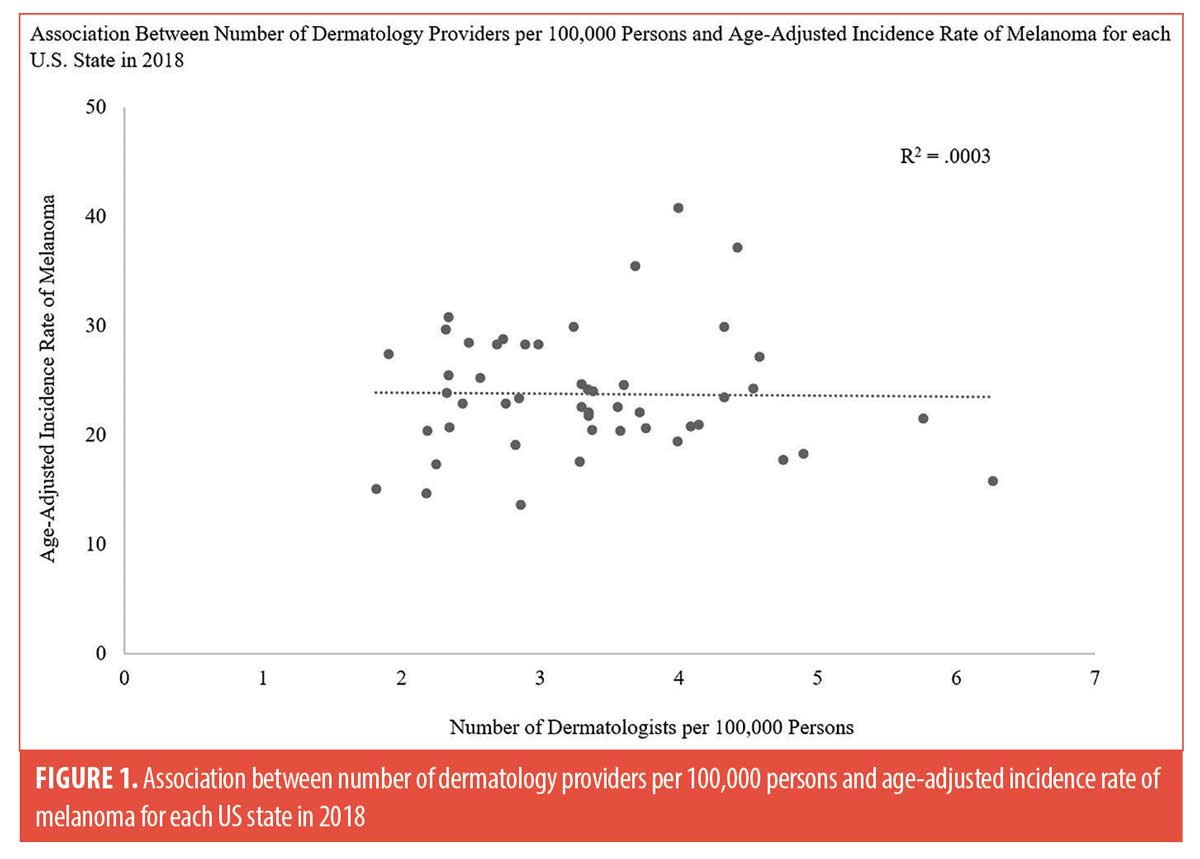 Lack of Association Between Increase in Number of Dermatologists and Rise in Melanoma Incidence Rate
Lack of Association Between Increase in Number of Dermatologists and Rise in Melanoma Incidence Rate
J Clin Aesthet Dermatol. 2022;15(9):14-15.
Dear Editor:
The determination of contributory factors to disease incidence is very difficult. Melanoma poses even more difficulties since the disease, by nature, is multifactorial. The effective exploration of questions related to melanoma attribution with an ecological study design is almost impossible. The incidence rate of melanoma in the United States of America (US) has increased in the last few decades, leading to questions regarding the contributing reasons.
There has been concern whether the increase in incidence represents an epidemic in the true occurrence of melanoma or whether increases in screening1 and increases in dermatologist density combined with lower pathological thresholds to label the morphologic changes as melanoma may be partially responsible. The objective of this analysis was to investigate whether the change in density of dermatology providers in each state over the last six years is associated with the change in diagnosis rate of melanoma per state over the same time period, adjusting for environmental and population characteristics.
Age-adjusted melanoma incidence rates for each state were acquired from Center for Disease Control and Prevention’s US Cancer Statistics Working Group.2 The number of dermatologists per 100,000 persons (density) in each state was calculated from the Medicare Provider Utilization and Payment Data3 and the U.S. Census Bureau.4 Two linear regressions were performed:
- Between dermatologist density and age-adjusted incidence rate of melanoma for each US state in 2018
- Between change in number of dermatology density from 2013 to 2018 for each state and the change in melanoma incidence rate over the six years for the same state.
Data for each state was compared in 2018 to that for the same state in 2013 to control for environmental factors, such as sunlight, climate, and ultraviolet (UV) index etc., and population characteristics that could affect the incidence rate of melanoma, as there should be minimal change in these factors in each state over the six years. The time period (2013–2018) was chosen as Medicare data for the number of dermatology providers was available from 2013 to 2019, while incidence from melanoma data was available only up to 2018. A statistical analysis was carried out in SPSS5 (version 27.0). The analysis assumed that dermatologists diagnose all melanomas; however, some of the melanomas might have been self-diagnosed or diagnosed by a primary care physician.
The incidence rate of melanoma in the US increased from 21.3 per 100,000 persons in 2013 to 22.0 per 100,000 persons in 2018. The average number of dermatologists per 100,000 persons in the US increased from 3.2 in 2013 to 3.4 in 2018. The association between the number of dermatology providers per 100,000 persons and age-adjusted incidence rate of melanoma for each US state in 2018 had a correlation coefficient of 0.02 (p=0.9) and R2 of 0.0003 (i.e. 0.03% of the variation in melanoma incidence can be explained by the change in number of dermatologists) (Figure 1). The association between change in dermatology density and the change in melanoma incidence at the state level from 2013 to 2018 had a correlation coefficient of 0.06 (p=0.7) and R2 of 0.003 (Figure 2).


While both the incidence rate of melanoma and the number of dermatology providers per 100,000 persons have increased in the last years, the increase in dermatologists might not be the driving force in increase of melanoma diagnosis rate. Instead, the rise in the incidence rate of melanoma might be due to increased detection of undiagnosed melanoma or a true increase in melanoma incidence, which should be further assessed.
With regard,
by Alan B. Fleischer, Jr., MD, and Pushkar Aggarwal, MD, MBA
Affiliations. Both authors are with the College of Medicine at the University of Cincinnati in Cincinnati, Ohio.
Funding. No funding was provided for this article.
Disclosures. Dr. Fleischer is an investigator for Galderma and Trevi and a consultant for Boehringer Ingelheim, Incyte, Qurient, SCM Life Science and Syneos.
Correspondence. Pushkar Aggarwal, MD, MBA; Email: aggarwpr@mail.uc.edu
References
- Welch HG, Mazer BL, Adamson AS. The Rapid Rise in Cutaneous Melanoma Diagnoses. N Engl J Med. 2021;384(1):72–79.
- Centers for Disease Control and Prevention and National Cancer Institute. U.S. Cancer Statistics Working Group. U.S. Cancer Statistics Data Visualizations Tool, based on 2020 submission data (1999-2018): U.S. Department of Health and Human Services. Published June 2021.
- Center for Medicare & Medicaid Services. Medicare Provider Utilization and Payment Data: Physician and Other Supplier.; 2021.
- United States Census Bureau. National Population Totals and Components of Change: 2010-2019. Census.gov.
- IBM Corp. IBM SPSS Statistics for Windows Version 27.; 2020.

